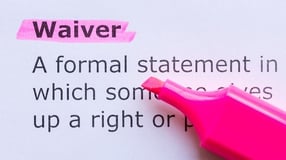
I hope you are enjoying these dives into the "Construction Alliance" and the "Construction Guidelines". This month, we will take a look into the world of pay applications, particularly lien waivers. The September guideline of the month is one of the shorter ones, but a very important concept to understand. When used properly, "Partial Lien Waivers" are an important part of protecting the Owner and the Contractor from unpaid bills. In the end, I hope you will better understand why partial lien waivers are important to both the Owner and the Contractor. This article and guideline are not intended to be legal guidance, just to raise awareness. If you are considering filing a lien or have had one filed against you, you should consult legal counsel.
What are lien waivers?
According to the newly released Project Delivery Practice Guide, published by the Construction Specifications Institute, a lien is "the legal right of a party or claimant, such as a subcontractor, to control the improved property of another or have it sold for payment of a claim." This allows the Contractor or sub-contractor to file a mechanic's lien against the property. Simply put, the mechanic's lien is a legal document filed by contractors or suppliers who never received payment for services or goods provided. A lien is filed against the property until the money due to the Contractor is paid in full. Lien laws vary by state and should be researched for each particular job location.

Why are lien waivers important?
When a lien is filed against a property, the entity filing the lien has essentially put themselves at the head of the line to receive payment before a property can be legally sold. There are two types of lien waivers, a partial (conditional) lien waiver, and a final (unconditional) lien waiver.
When are lien waivers issued?
Lien waivers are issued at different phases during construction. A Contractor will submit their pay application and a partial lien waiver for the amount being requested. This lien waiver is conditional upon receipt of payment in full for the amount being requested by the Contractor. Along with the pay application, the Contractor will issue partial lien waivers from sub-contractors and suppliers for work performed during the previous months work.
Upon the final application for payment, the Contractor will issue a conditional final lien waiver indicating that the job has been completed in full, and the monies due the Contractor have been paid in full. At the same time, the Contractor will need to turn in final lien waivers from subcontractors and suppliers, indicating that the Contractor has paid them in full and that no liens exist on the completed construction project.
Who verifies lien waivers?
The Owner and Owner's lender are the ones who will ultimately be responsible for verifying lien waivers. However, in the pay applications chain, the Contractor will verify that they have received all lien waivers from the sub-contractors and suppliers. The Architect/Engineer should verify that the pay application contains partial lien waivers from the previous pay application before forwarding to the Owner.

The value of lien!
Assume for a moment that you own a widget shop. The specifier has indicated that your widget is to be used on a particular project. You go through the process of supplying your widget to the Contractor for installation on a project. It then gets appropriately installed and has been accepted by the Contractor, Architect, and Owner. So, as a widget maker, you are owed money by the Owner through the Contractor. Here are some potential scenarios where a lien waiver comes in handy:
- The Owner pays the Contractor, the Contractor pays you, and you provide a lien waiver to the Owner. All parties go away happy, and this is the way it should go.
- The Owner pays the Contractor, the Contractor does not or forgets to pay you. You send notice to the Owner and Contractor that you are preparing to file a lien unless payment is received in full. The Contractor sees the mistake and pays you, and you send a lien waiver, or the Owner calls the Contractor and strongly suggests they pay you quickly. Either way, you get paid.
- The Owner doesn't pay, for whatever reason, so you send notice to the Owner and Contractor that you are preparing to file a lien unless paid. Upon seeing their error, the Owner forwards payment, and all goes well.
- The Owner or Contractor doesn't pay, and you file a lien against the property. Years later, when the Owner is finished with the property and goes to sell the property, the Owner finds your lien has been filed. Prior to selling, they must make payment to you in order to receive a lien waiver.
- The other way to gain payment is filing a lawsuit, but those often take time and more money.
Please make certain to read the guideline "Partial Lien Waivers", and if you have any comments, please let me know. Continuing the money trend next month, I'll break down "Payment for Extra Work - Cost Plus Fee".
Till next month…
Steve Gantner RA, CSI, AGCMO, SCIP, CCS, CCCA
Senior Specifier - Conspectus, Inc.





